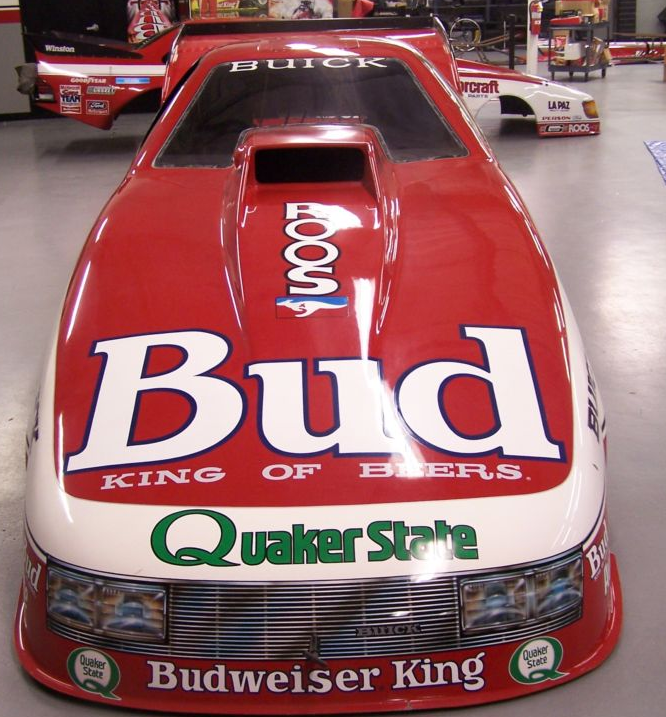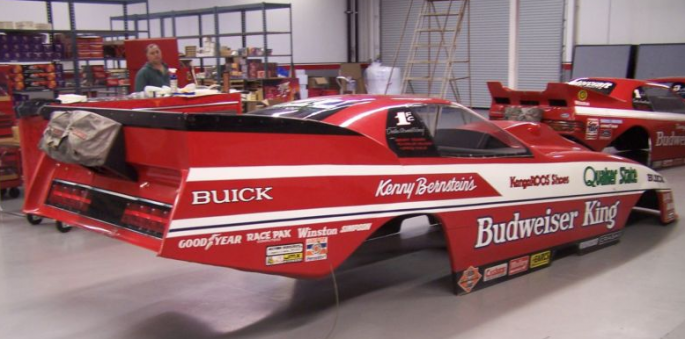BELIEVE IT OR NOT; BERNSTEIN'S BATMOBILE FIT THE RULES OF ITS DAY
 Iconic drag racer Kenny Bernstein said Dale Armstrong best explained their working relationship, which yielded multiple championships.
Iconic drag racer Kenny Bernstein said Dale Armstrong best explained their working relationship, which yielded multiple championships.
"He said, 'Kenny, you go out and find the money, and I spend it," Bernstein recalled with a laugh.
This relationship can be attributed to the transformation of recognizable Funny Car designs to a one-size-fits-all box type configuration only recognizable through graphics.
The Batmobile, the nickname given to the Budweiser-sponsored Buick Reatta that Bernstein drove to an NHRA championship in 1987, was a project the King of Speed paid for dearly.
"It was all Dale's idea, which of course I was for it, because if it made us be more successful and win, sure. Why not?" Bernstein recalled. "So Dale tells me he wants to build his own body and it will resemble a Buick Reatta. And he says, 'And we got to start from scratch and it's going to cost about $300,000 to do this."
Once Bernstein regained his senses, all he could say was, "Oh wow."
Unlike today's rulebook, where prior approval is a must, the thought process was that it has to be legal if it's not in the rulebook.
 "Now you have to remember in those days there were no specific rules on building our bodies," Bernstein said. "They were pretty opened up. There was nothing there. So I said, 'Yeah, let's do it."
"Now you have to remember in those days there were no specific rules on building our bodies," Bernstein said. "They were pretty opened up. There was nothing there. So I said, 'Yeah, let's do it."
"If you think this will be something special, then yeah. Why not? This is a chance we can do this thing. So I said, 'I'm in there with you."
"I said, 'We'll put it in the budget and just do it."
Armstrong was a mad scientist on a mission to build the perfect beast.
"About seven-eighths of the way through it, he had it sitting over at the shop where he was doing all this work," Bernstein recalled. "He said, 'Well, you better come over and take a look at this thing and see what you think."
Nothing could have prepared Bernstein for the black, carbon fiber shell which awaited him when the shop door opened.
"It had just come out of the mold and it was sitting up on sawhorses," Bernstein recalled. "I went over there to see what it was, and I said, 'You've got to be kidding me. Dale, what have you done? My goodness me, there's no way that this thing's going to be approved."
"I said, 'My goodness me."
"He said, 'Well, there's no rules on any of it. And it didn't any more resemble any kind of Funny Car that had ever been built at that time. None."
Bernstein could only imagine if this was his reaction, and he was taken aback, what the reaction would be from the NHRA. Bernstein took his best diplomatic approach as Dallas Gardner, Steve Gibbs, and Graham Light walked into the shop to see what some Funny Car aficionados described as the devil in carbon fiber.
"They walked up and they looked at this car, and I mean, they're walking around it. And I see them over in corners talking to each other and huddling," Bernstein recalled. "Dallas came over to me, and he says, 'Kenny, we got to go to lunch and think about this a minute."
 So I said, "Okay, see you later, I'll be here." Bernstein said. "He said, 'We'll be back in an hour or so."
So I said, "Okay, see you later, I'll be here." Bernstein said. "He said, 'We'll be back in an hour or so."
Bernstein looked at his crew chief and uttered, "This is a 300,000 investment. I sure hope we get to run it."
Gibbs still remembers the day he first laid eyes on the Batmobile.
"It fit the rules of the time," Gibbs said. "The rules of the era might have been weak, but it fit into them. But at the time, the cars were getting faster and faster, and aerodynamics were starting to play a part in stability.
"It definitely pushed the edge of the rules, which were pretty vague. Maybe we cringed a bit when we saw it the first time."
The NHRA visitors broke from their lunch, and it was then President Gardner who delivered the news to Bernstein.
"We're going to approve this - this time. But you got one year, and that's it," Gardner said. "After that, we're going to come up with some rules. Some rules that will solve this continued evolution problem that's going on."
Bernstein responded, "One year?" I've got 300,000 invested in this thing." NHRA didn't budge on what some believe was a more than generous ruling.
Bernstein realized he had a bigger problem to face than NHRA longevity.
"I had a problem with Buick, trying to convince them that this was going to be one of their cars, resemble one of their cars they were making production out of Detroit," Bernstein added.
Bernstein admitted the sell to Buick wasn't easy either.
"When it came to winning, everybody made an exception to the rule," Bernstein said.








































